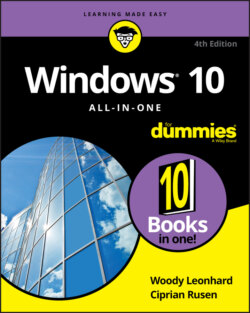Читать книгу Windows 10 All-in-One For Dummies - Ciprian Adrian Rusen, Woody Leonhard - Страница 44
The Different Kinds of Windows Programs, Er, Apps
ОглавлениеWindows 10 runs two very different kinds of programs. Permit me to go back to basics.
Computer programs (call them applications or desktop apps if you want) that you and I know work by interacting with an operating system. Since the dawn of Windows time, give or take a bit, Windows apps have communicated with Windows through a specific set of routines (application program interfaces or APIs) known colloquially and collectively as Win32. With rare exceptions, Windows desktop apps — the kind you use every day — take advantage of Win32 APIs to work with Windows.
In early June 2011, at the D9: The D: All Things Digital conference in California, Steven Sinofsky, and Julie Larson-Green gave their first demo of Windows 8. As part of the demo, they showed off new immersive or Metro apps, that interact with Windows in a different way. They use the newly minted (and still evolving) API set known as Windows Runtime or, more commonly, the WinRT API.
Microsoft started calling the WinRT based apps “immersive” and “full screen.” Most of the world settled on Microsoft’s internal code name, Metro. Microsoft, however, has since changed the name to Modern UI, then Windows 8, Windows Store App, New User Interface, Microsoft Design Language, Microsoft style design, and more recently Modern and Universal. The preferred terminology used to be Universal Windows Platform (UWP) app, although the tech support folks reverted to Universal app all the time. In recent times, Microsoft has decided to ditch the UWP platform, and add its functionality to non-UWP software development platforms. Therefore, UWP is now dead. I continue to use the term Metro in normal conversation, but in this book, to minimize confusion, I use the terms Windows 10 app or app.
Don’t be confused. (Ha!) They all mean the same thing: Those are the names for Universal Windows applications that run with the WinRT API.
Windows 10 (Modern, Metro) apps have many other characteristics: They’re sandboxed — stuck inside a software cocoon that isolates the programs so that it’s hard to spread infections through them. They can be easily interrupted, so their power consumption can be minimized; if a UWP app hangs, it’s almost impossible for it to freeze the machine. But at their heart, Universal Windows Platform apps are written to use the WinRT API.
Windows 8 and 8.1 (and Server 2012) support the WinRT API — Universal apps run on the Metro side of Windows 8, not on the desktop. ARM-based processors also run the WinRT API. You can find ARM architecture processors in many smartphones and tablets. In theory, apps should run on any Windows 10 computer — a desktop, a laptop, a tablet, a phone, a wall-mounted Surface Hub, an Xbox, and even a HoloLens headset. In practice, however, it isn’t quite so simple. For example, only the simplest app that works in Windows 10 will run in Windows 8. So “Universal” is something of an aspiration, not a definition.
In Windows 10, UWP (Modern/Metro/Tiled) apps run in their own boxes, right there on the desktop. Look at the Weather app — formerly a UWP app, now a Windows 10 app — shown in Figure 2-3.
All the other Windows programs — the ones you’ve known since you were still wet behind the WinEars — are now called desktop apps. Five years ago, you would’ve just called them programs, but now they have a new name. After all, if Apple can call its programs apps, Microsoft can, too. Technically, old-fashioned Windows programs, applications, or desktop apps are built to use the Win32 API.
